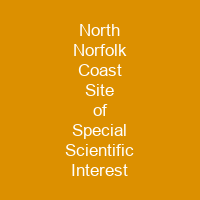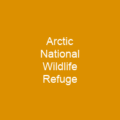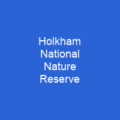The North Norfolk Coast SSSI: A Natural Wonder
Imagine a place where nature and history intertwine, where the wind whispers secrets of ancient times, and the sea cradles life in its embrace. The North Norfolk Coast Site of Special Scientific Interest (SSSI) is such a place—a treasure trove of biodiversity and archaeological significance that stretches along 43 kilometers of England’s north coast.
Wildlife Wonders
Within this vast expanse, you’ll find reed beds, salt marshes, freshwater lagoons, and sand or shingle beaches. These habitats support a wide range of wildlife, including the elusive pied avocets, western marsh harriers, and Eurasian bitterns. As you walk along the coast, you might spot ducks and geese migrating through, adding to the vibrant tapestry of life.
Archaeological Treasures
The SSSI is not just a sanctuary for wildlife; it’s also a window into our past. From Upper Paleolithic tools to Roman naval ports, this area holds stories from various epochs. The National Trust has played a crucial role in preserving these sites, ensuring that future generations can learn from the past.
Economic Importance
The North Norfolk Coast is economically vital due to its tourism industry, particularly birdwatching. However, managing this site requires careful planning to protect sensitive habitats from visitor impact. The Environment Agency’s managed retreat strategy aims to safeguard these areas for the long term.
Historical Highlights
The coast has seen its share of history, with early Bronze Age sites like Seahenge and Roman settlements such as Branodunum. During World War I and II, military installations were built along the shore, leaving behind tangible reminders of that era.
Conservation Efforts
The SSSI is protected through various designations, including Natura 2000, SPA, and Ramsar listings. It’s also part of the Norfolk Coast Area of Outstanding Natural Beauty (AONB) and a Biosphere Reserve. These protections ensure that this unique ecosystem remains intact for future generations.
Visitor Facilities
To enhance your experience, there are several nature reserves and facilities along the coast. The National Trust’s information centre at Morston quay offers insights into the area’s history and ecology. Visitors can also explore bird hides and enjoy guided tours.
The Impact of Tourism
While tourism brings economic benefits, it also poses challenges. Measures are in place to minimize disturbance to wildlife, such as wardening breeding colonies and using fences and boardwalks. The Norfolk Coast Partnership divides the coast into zones for sustainable development.
Climate Change Threats
The North Norfolk Coast faces significant threats from climate change, including rising sea levels and increased coastal erosion. Efforts are underway to mitigate these impacts, such as creating new reserves inland and managing river routes to prevent flooding.
A Call to Action
As you explore the North Norfolk Coast SSSI, remember that every step taken is a contribution to its preservation. Whether it’s through supporting local conservation efforts or simply being mindful of your impact on this fragile ecosystem, we all play a role in ensuring that these natural wonders remain for future generations.

Together, let’s protect and cherish the North Norfolk Coast SSSI. It’s not just a place; it’s a living, breathing testament to our shared heritage and responsibility.
You want to know more about North Norfolk Coast Site of Special Scientific Interest?
This page is based on the article North Norfolk Coast Site of Special Scientific Interest published in Wikipedia (retrieved on December 9, 2024) and was automatically summarized using artificial intelligence.







